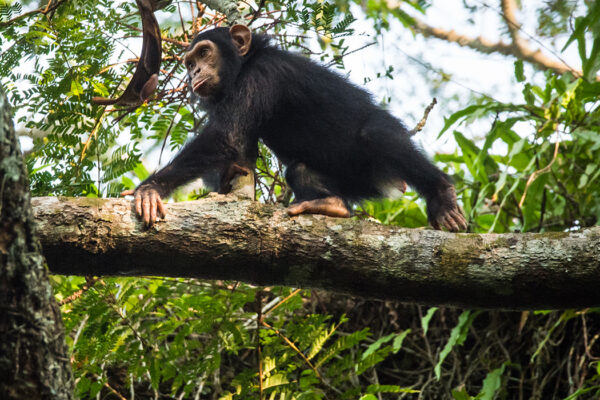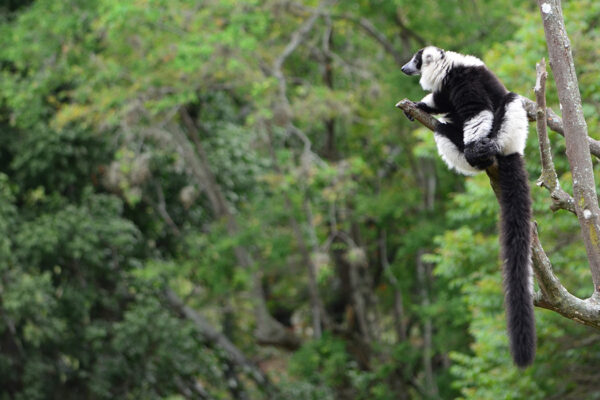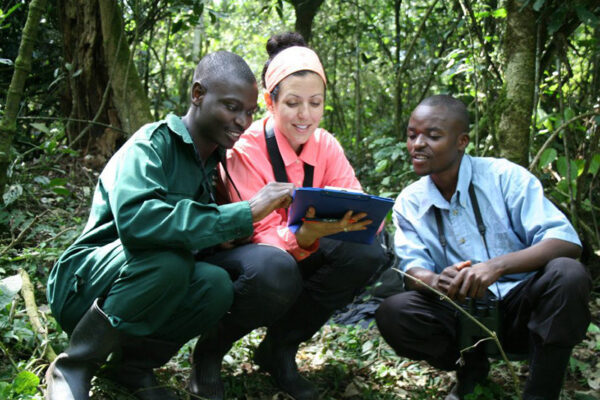“None of us can do it alone, can we?” asked Jane Goodall.
She paused. The world-renowned ethologist has never been afraid of silence.
With white hair pulled back into her characteristic ponytail, Goodall spoke without notes to a packed audience for an Assembly Series lecture, “Dr. Jane Goodall: Inspiring Hope Through Action,” in Graham Chapel. Her visit to Washington University on Oct. 9 was part of her first U.S. tour since the COVID-19 pandemic brought international travel to a halt.

“We walk through life. We have a certain path,” Goodall continued. “And there are people around us who help us along the path — who help us when we fall or falter, who pick us up and say, ‘Come on, carry on. You have it in you.’ There have been so many people in my life who have helped me along my road.”
But there was one person that Goodall wanted to single out.
“Maybe she’s listening to us in this lovely space,” Goodall said, with a glance up to the stained-glass windows. “I like to think she is.”
That person was her mother Vanne Goodall, of course, best known for accompanying 26-year-old Goodall on her first research expedition in Tanzania. Goodall recalled an even earlier moment when her mother indulged her naturally inquisitive mind.
Vanne was the one who looked into 4-year-old Jane’s shining eyes and chose to listen to the news that Jane urgently wanted to share — the wonderful story of how a hen lays an egg — rather than scolding young Jane for disappearing into a chicken coop for several hours to observe the miracle (the police were later called off).
“It was my mother’s support, and her wisdom, that has enabled me to be who I am. A different mother might have crushed that early scientific curiosity.”
— Jane Goodall
Because of Vanne, the world got Jane. And because of Jane, how many others?
An army of female scientists, inspired by Goodall’s trailblazing primate research, including Washington University’s Krista Milich, Crickette Sanz and Emily Wroblewski. Their students and graduate students of all genders. Thousands of children participating in Roots & Shoots, the international youth program of the Jane Goodall Institute that supports young people in more than 60 countries to create positive change in their communities. And countless others, young and old, inspired by Goodall’s message of hope.
“Jane truly was a pioneering woman in primatology, and she paved the way for the careers of all of us who have followed her,” said Wroblewski, assistant professor of biological anthropology in Arts & Sciences.
“I think Jane is so appealing because she gives us hope in times when it can feel like there is not any, and when it can feel like the problems are too big for any one of us to solve,” said Wroblewski, who did her doctoral dissertation research at Gombe National Park in Tanzania on chimpanzees and who continues to study them as part of her research. “Her message — that each person can do their small part, and that all those individual small parts can add up to big change in the world — inspires people to have hope and take action.”
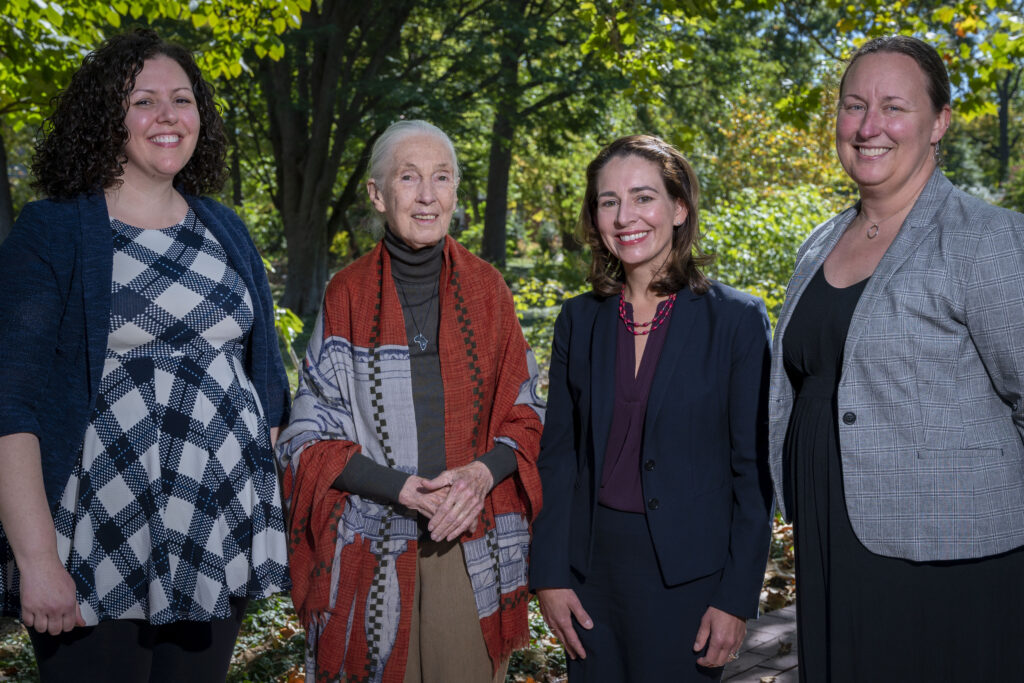
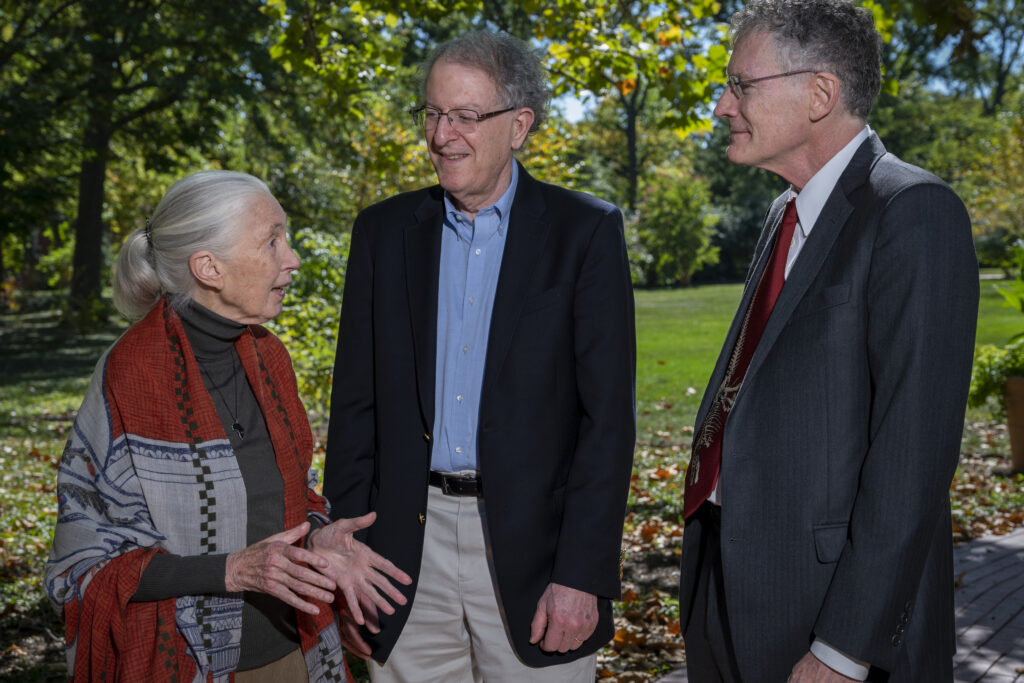


Becoming Jane
On a bright fall Sunday afternoon, Jane Goodall, DBE, founder of the Jane Goodall Institute and UN Messenger of Peace, spoke with 750 members of the Washington University community in person — and about 1,000 more by livestream — to share insights on her evolution from curious young girl to intrepid scientist to global icon. Her talk coincided with the launch of the exhibition “Becoming Jane: The Evolution of Dr. Jane Goodall” at the Saint Louis Science Center.
Jonathan Losos, director of the Living Earth Collaborative and the William H. Danforth Distinguished University Professor in the Department of Biology in Arts & Sciences, introduced Goodall at the WashU event. The program was presented by the Office of the Provost, the Living Earth Collaborative and the McDonnell International Scholars Academy, in partnership with the Saint Louis Science Center.
“It is no exaggeration to say that her research not only transformed our perception of our nearest evolutionary relatives, the chimpanzees, but fundamentally changed our conception of what it is to be human. Today, Dr. Goodall’s mission has evolved into a quest to empower every individual to make the world a better place for people, other animals and the world we share.”
— Jonathan Losos
Goodall’s six-plus decades of work began in 1960, when she arrived on the shores of Lake Tanganyika in what is now Gombe National Park, Tanzania. Equipped with little more than binoculars, a notebook and her fascination with wildlife, Goodall ventured into what was then called the Gombe Stream Chimpanzee Reserve — embarking on a journey that would redefine the relationship between humans and other animals and ultimately help shape the burgeoning strategies of world conservation into the 21st century.
Her published findings on the tool-making practices of chimpanzees remain one of the most highly regarded observations in animal behavior research.
Addressing listeners in Graham Chapel, Goodall said: “Most of you here know something about how chimpanzee behavior resembles ours. But back then it was so exciting to see them — kissing, embracing, holding hands, reassuring one another with gentle patting.
“It was so exciting to see how young ones intently watched their elders and imitated what they saw,” she said. “Gradually we found out that the female doesn’t have her first baby until she’s 10 to 13, then she only has one child every five years. And even when the next baby is born, and the oldest child is 5 years old, that older child still stays with the mother and is emotionally dependent on her, so that the bonds between mother and child and siblings get stronger and stronger.”
During her wide-ranging talk, Goodall discussed her early life and aspirations as well as some of the challenges she faced in communicating her revolutionary findings with other scientists. She also described the critical connection between the plight of chimpanzees and that of the people living in and around their forest habitats.
The innovative community-led conservation approach that Goodall developed — known as “Tacare” — puts local people and institutions at the center of finding solutions to the complex problems driving conservation challenges. A new book created in partnership between the Jane Goodall Institute and Esri, called Local Voices, Local Choices, describes the success of this holistic approach of conservation driven by local communities and their stories.
“When Jane began her work, there were no examples to follow — she had to figure things out as she went along, and we’ve all benefitted from learning from her experiences,” said WashU’s Milich, assistant professor of biological anthropology in Arts & Sciences. At Kibale National Park, Uganda, where Milich studies red colobus monkeys, she has helped community members with a project aimed at reducing the instances of animals from the park eating or damaging the crops of nearby subsistence farmers. “It is so important to have someone as influential as Jane Goodall emphasizing the fact that working with local communities is essential for successful conservation.”
‘Absolute magic’
At the end of Goodall’s remarks, WashU’s Sanz joined her on stage to moderate a Q&A session. The two reminisced about the 2003 trek to reach the remote field station that Sanz and her husband and collaborator David Morgan, research fellow at Lincoln Park Zoo in Chicago, established in the Goualougo Triangle in Congo.
The large tracts of forest in the Congo Basin are a conservation stronghold not only for chimpanzees and gorillas but also forest elephants, leopards and many other species. There, the government of the Republic of Congo and the Wildlife Conservation Society have worked together for nearly three decades to save wild places that sustain the local people, protect natural resources and buffer global climate change.
Goodall described walking more than 12 miles to join Sanz and Morgan at the Goualougo Triangle, crossing the swampland and rivers that border the forest — waterways that had acted as a barrier to humans in the recent past.
“That time in the Goualougo Triangle was very fragile to us because that’s when the forest was gazetted to be logged,” said Sanz. As it happened, after visiting the area, Goodall went directly to meet with the president of the Republic of the Congo to talk about her visit to these remote and pristine forests. Her lobbying efforts ultimately helped increase the area of protected status. “And it’s something that I don’t think I’ve ever formally thanked you for,” Sanz continued, “all of your efforts to make sure that the area would be annexed to the national park (Nouabalé-Ndoki National Park). Thank you so much.”
“It was one of the most amazing trips I’ve ever had,” Goodall said. “It was the first time I saw gorillas. And the chimpanzees! It was absolute magic.”
“That forest has remained intact because of you and your efforts,” Sanz said. “Those chimpanzees that you met, we discovered and just published last week that they play with the gorillas … we see them together more often than we ever thought. And we have so many more discoveries to come.”



Sanz said she was fortunate to explore the Goualougo Triangle with Goodall the naturalist.
“She would appreciate individual trees and pick up brightly covered colored leaves to take back to her friends. And notice little details that others just quickly walked past,” Sanz said. Her graduate students are still studying chimpanzee behaviors that Goodall identified during that visit. (See The New York Times for the latest on this research.)
One of those students, Jake Funkhouser, a doctoral candidate of biological anthropology in Arts & Sciences, was among those who went to the microphone during a Q&A session that followed Goodall’s remarks. Funkhouser asked Goodall about where her inspiration to be a brave and innovative leader comes from.
“Jane’s response to my question flipped the concept of leadership on its head,” Funkhouser later told Washington Magazine. “She doesn’t consider herself to be a leader. She is simply Jane — the same person who was befriending earthworms and mystified by hens laying eggs in Bournemouth, England, just a few years before World War II. She reminded us that absolute authenticity is truly the most enduring characteristic of a leader.
“From Jane’s perspective, leadership is not at all about having followers,” Funkhouser says. “For all of us underrepresented and historically excluded identities on campus, I hope this message of tenacious authenticity is one we carry with us forever — I certainly will.”
Still time to act
Goodall says that universities like WashU have a special role to play in conservation in the choices they make with their curriculum.
“If students are prepared by learning about the environmental challenges we face, by learning about climate change, by learning about loss of biodiversity, then a university already is playing a very great role in raising awareness and training young people,” Goodall told Washington.
Consortia such as the Living Earth Collaborative — the regional partnership formed by Washington University, the Saint Louis Zoo and the Missouri Botanical Garden dedicated to advancing the knowledge of biodiversity — also help fulfill a crucial mission.
“The problems we face today are so huge that no one organization can do it alone,” Goodall said. “I’m always urging more and more groups to join together. Different groups will have different takes and do slightly different parts of a whole big problem, and the more the better.”
Goodall continues: “Often it just means getting rid of egos. Sometimes there’s a problem of funding. But that’s something we ought to tackle, so that people can work together in a big group.”
So, to answer the obvious question — yes, Jane Goodall still has hope for the future, and she thinks you should have hope, too.
“We’ve still got a window of time. If we get together, and we all play our part, then we can start to heal some of the wounds we have inflicted. We can start to reverse the trend of climate change and biodiversity loss.”
— JANE GOODALL
Her No. 1 reason for hope is the enthusiasm and effort of young people in the world.
“Right now, around the world there are young people — hundreds of thousands of them, and the people who’ve been through Roots & Shoots who are now in adult positions. And they’re working to make this a better world,” Goodall told the audience at Graham Chapel.
“Secondly, the human brain,” she said. “It’s the biggest thing that differentiates us from the rest of the animals. And, yes, animals are way, way, way more intelligent than we used to think. But none of them could design the internet. None of them could design a rocket going up to Mars.”
A third reason for hope, Goodall said, is the resilience of nature.
“Fly over Gombe today, and you won’t see bare hills anymore,” she said. “People are rising out of poverty. They are being given the tools to improve their own lives at the same time as not destroying the environment. Animals on the brink of extinction can be given another chance.”
The final reason for hope that she shared is what she calls the indomitable human spirit.
“There are people tackling seemingly impossible problems and not giving up, and so often succeeding,” she said.
“Every single individual makes an impact every single day.”
Reaching for our star
Goodall learned an important and timeless lesson as a very young girl: “My mother always told me if you really want to do something, you’re going to have to work extraordinarily hard, take advantage of every opportunity, and if you don’t give up, maybe you’ll find a way.”
Vanne’s message for young Jane is one that Goodall finds all the more urgent these days.
“I liken our species right now, as if we are at the mouth of a very long and very dark tunnel. And right at the end of that tunnel is a little star shining. That’s hope.”
— Jane Goodall
She continued: “Between us and that star, there are hundreds and hundreds of problems. But it’s no good hoping the star will come to us. No, we have to roll up our sleeves.
“We have to crawl under, climb over and work our way around all the problems that lie between us and the star,” she said.
“It’s not too late. But we all must get together and do our part and make choices every day that will benefit the world, and not cause extra harm.”

